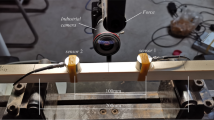Abstract
Acoustic emission (AE) monitoring was used to trace directly the fracture intensity in cylinders of lime wood subjected to variations in temperature and relative humidity (RH) in their environment. High-frequency components produced by mechanical fracturing were extracted from the raw AE signals using the wavelet transforms. The accumulated energy of these components depended on the magnitude and rate of the RH variations. The AE activity correlated well with predictions of the numerical modeling carried out as the first part of the present investigations. In particular, the AE activity became negligible below the allowable magnitude for the rapid RH variation predicted by the simulation, or when the time interval allowed for the RH variation was long enough. Furthermore, AE proved capable of tracing the progressive evolution of damage at the microlevel, which preceded failure of wood discernible from the macroscopic perspective.









Similar content being viewed by others
References
Aicher S, Höfflin L, Dill-Langer G (2001) Damage evolution and acoustic emission of wood at tension perpendicular to fiber. Holz Roh- Werkst 59:104–116
Beall FC (2002) Overview of the use of ultrasonic technologies in research on wood properties. Wood Sci Technol 36:197–212
Beall FC, Breiner TA, Wang JW (2005) Closed-loop control of lumber drying based on acoustic emission peak amplitude. Forest Prod J 55:167–174
De Reyer D, Maurin E, Daudet L, Fontaine JM (2005) Les signaux émis par les larves d’insectes xylophages et la detection acoustique. In: Verger I (eds) ICOM Committee for Conservation, 14th Triennial meeting, The Hague, Preprints, vol. II, James and James, London, pp 1068–1074
Gonzales de la Rosa JJ, Puntonet CG, Lloret I (2005) An application of the independent component analysis to monitor acoustic emission signals generated by termite activity in wood. Measurement 37:63–76
Jakiela S, Bratasz L, Kozlowski R (2007a) Numerical modeling of moisture movement and related stress field in lime wood subjected to changing climate conditions. Wood Sci Technol (in press)
Jakiela S, Bratasz L, Kozlowski R (2007b) Acoustic emission for tracing the evolution of damage in wooden objects. Stud Conserv (in press)
Kowalski SJ, Molinski W, Musielak G (2004) The identification of fracture in dried wood based on theoretical modeling and acoustic emission. Wood Sci Technol 38:35–42
Lee SH, Quarles SL, Schniewind AP (1996) Wood fracture, acoustic emission, and the drying process. Part 2: Acoustic emission pattern recognition analysis. Wood Sci Technol 30:283–292
Raczkowski J, Moliński W, Ranachowski Z (1994) Acoustic emission in fracture mechanism of wood. J Theor Appl Mech 32:299–322
Raczkowski J, Lutomski K, Moliński W, Woś R (1999) Detection of early stage of wood decay by acoustic emission technique. Wood Sci Technol 33:353–358
Rice RW, Phillips DP (2001) Estimating the moisture excluding effectiveness of surface coatings on Southern Yellow pine using acoustic emission technology. Wood Sci Technol 34:533–542
Schniewiend AP, Quarles SL, Lee SH (1996) Wood fracture, acoustic emission, and the drying process. Part 1: Acoustic emission associated with fracture. Wood Sci Technol 30:273–281
Acknowledgments
A substantial part of this research was done within two projects supported financially by the European Commission 6th Framework Programme: “Global climate change impact on built heritage and cultural landscapes” (NOAH’S ARK) and “Sensor systems for detection of harmful environments in pipe organs” (SENSORGAN). Further this work was supported in part by grant 1 H01E 010 30 from the Polish Ministry of Science and Higher Education.
Author information
Authors and Affiliations
Corresponding author
Rights and permissions
About this article
Cite this article
Jakieła, S., Bratasz, Ł. & Kozłowski, R. Acoustic emission for tracing fracture intensity in lime wood due to climatic variations. Wood Sci Technol 42, 269–279 (2008). https://doi.org/10.1007/s00226-007-0156-3
Received:
Published:
Issue Date:
DOI: https://doi.org/10.1007/s00226-007-0156-3




